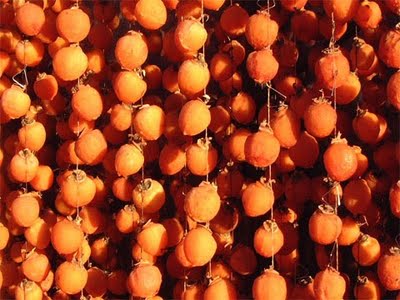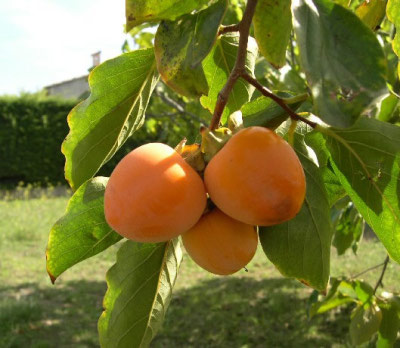
American and Asian persimmons
 Although I'm primarily
interested in growing
persimmons as food for livestock, the persimmon has a long
history as a people food. Here in the United States, Native
Americans added the fruit to their cornbread as sweetener, dried the
pulp for winter fruit, ground seeds into meal, and even made a
beer-like drink by combining persimmons and honey locust pods. In
Asia, persimmons were such a large part of the traditional diet that
farmers cultivated varieties perfect for eating fresh and others just
for drying, then planted them in large orchards. American
cookbooks that are at least a few decades old often include recipes for
persimmon bread and persimmon pudding, the former of which tastes to me
a lot like banana bread.
Although I'm primarily
interested in growing
persimmons as food for livestock, the persimmon has a long
history as a people food. Here in the United States, Native
Americans added the fruit to their cornbread as sweetener, dried the
pulp for winter fruit, ground seeds into meal, and even made a
beer-like drink by combining persimmons and honey locust pods. In
Asia, persimmons were such a large part of the traditional diet that
farmers cultivated varieties perfect for eating fresh and others just
for drying, then planted them in large orchards. American
cookbooks that are at least a few decades old often include recipes for
persimmon bread and persimmon pudding, the former of which tastes to me
a lot like banana bread.
There are dozens of
species of persimmons scattered around the world, but most people
talking about persimmons are interested in just two species. The
persimmon cultivated in Asia (and which you can find in fancy
supermarkets in the U.S.) is primarily Diospyrus
kaki, which has
large fruits that ship well and often competely lack the  puckery astringency that
marks our native persimmon when the fruits aren't quite ripe. A
few people grow the Asian persimmon (sometimes called "kaki", "Japanese
persimmon", or "oriental persimmon") in the United States, but
cultivation is risky north of zone 7, so I'm focusing on our native
species. If you live in the Deep South, the Asian persimmon is
worth looking into since you can find dozens of named varieties, at
least one of which is bound to suit your needs.
puckery astringency that
marks our native persimmon when the fruits aren't quite ripe. A
few people grow the Asian persimmon (sometimes called "kaki", "Japanese
persimmon", or "oriental persimmon") in the United States, but
cultivation is risky north of zone 7, so I'm focusing on our native
species. If you live in the Deep South, the Asian persimmon is
worth looking into since you can find dozens of named varieties, at
least one of which is bound to suit your needs.
The American persimmon (Diospyrus
virginiana) grows
wild throughout the southeast and is often ignored by locals in modern
times. Little work has been done on breeding tastier varieties
and the fruits have to turn to mush before they are fully ripe, so
they're impossible to ship and will probably never show up at your
local supermarket. On the other hand, the American persimmon is a
more dependable bearer of fruit than the Asian persimmon --- American
persimmons bloom late and are almost never impacted by spring
frosts. According to may people, the American persimmon has a
better taste and is also higher in nutrients like vitamin C and calcium
than the Asian persimmon.
| This post is part of our Persimmons lunchtime series.
Read all of the entries: |
Want more in-depth information? Browse through our books.
Or explore more posts by date or by subject.
About us: Anna Hess and Mark Hamilton spent over a decade living self-sufficiently in the mountains of Virginia before moving north to start over from scratch in the foothills of Ohio. They've experimented with permaculture, no-till gardening, trailersteading, home-based microbusinesses and much more, writing about their adventures in both blogs and books.
Want to be notified when new comments are posted on this page? Click on the RSS button after you add a comment to subscribe to the comment feed, or simply check the box beside "email replies to me" while writing your comment.

Please try to help me. I planted some persimmon seeds this Spring/Summer and all of them sprouted. Today July 19, 2012 they have 4 leafs. I know they will survive Summer but what about Winter time since I live in Ontario, Canada. Should I dig them out and when to bring them inside the house to overwinter, or should I try to protect them in the garden where I planted seeds. Should I bother at all because I am very (quite) old and there will not be time for me to see them growing into a big tree.
Please, tell me everything you know and your personal suggestion what to do.
Thank you all in advance,
Best wishes, Milos
Milos --- Persimmons hate to be transplanted, so they're a bad choice for planting outside their range and then digging up to take inside each winter. I would opt to protect them where they are, although I don't know how much luck you'll have with that in your climate.
If you grafted an Asian Persimmon onto your seedlings next year, you'd end up with a smaller tree that should bear earlier, which would make it much easier to protect when it matures.
Good luck!
anna, thank you so much. I will have to go to the garden centre and still some little persimmon tvig of Asian Persimmon to graft on to my seedling. I hope I succeed.
Please keep in touch.
Thank you very much, Milos
Hello, I just found your blog and noticed many entries are from several years ago. Are you still keeping it current? The reason for my email is to inquire as to how your persimmons from seed worked out? I have tried growing from seeds that happened to be in a store bought fruit. I got 4 to germinate and got to 4 leaves and then just stopped growing. The leaves lasted until November and eventually dried up and fell off. Maybe this was normal, I don't know. I brought them inside and put under a grow light for the winter. It's still just a stick and I'm wondering if it is just dead.
Is there a nursery or place to buy more seeds? I was actually trying to grow the round and flatter variety "Haku"? I can't recall the name just the shape.
I'm also located in the Pacific Northwest -- about 20 miles north of Seattle. Do you think any persimmon variety would survive in our climate?
I look foward to hearing from you soon.
Wendy